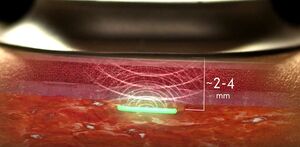Nanotechnology
(technology) | |
|---|---|
| Interest of | • AWZ Capital • Flemming Besenbacher • Ray Kurzweil • Charles Lieber • Metin Sitti |
Nanotechnology is the use of matter on an atomic, molecular, and supramolecular scale for industrial purposes. A generalized description of nanotechnology was established by the National Nanotechnology Initiative, which defined nanotechnology as the manipulation of matter with at least one dimension sized from 1 to 100 nanometers. This definition reflects the fact that quantum mechanical effects are important at this quantum-realm scale, and so the definition shifted from a particular technological goal to a research category inclusive of all types of research and technologies that deal with the special properties of matter which occur below the given size threshold. It is therefore common to see the plural form "nanotechnologies" as well as "nanoscale technologies" to refer to the broad range of research and applications whose common trait is size.
Nanotechnology as defined by size is naturally broad, including fields of science as diverse as surface science, organic chemistry, molecular biology, semiconductor physics, energy storage, and molecular engineering. The associated research and applications are equally diverse, ranging from extensions of conventional device physics to completely new approaches based upon molecular self-assembly, from developing new materials with dimensions on the nanoscale to direct control of matter on the atomic scale.
Scientists currently debate the future implications of nanotechnology. Nanotechnology may be able to create many new materials and devices with a vast range of applications, such as in nanomedicine, nanoelectronics, biomaterials energy production, and consumer products. On the other hand, nanotechnology raises many of the same issues as any new technology, including concerns about the toxicity and environmental impact of nanomaterials, and their potential effects on global economics, as well as speculation about various doomsday scenarios. These concerns have led to a debate among advocacy groups and governments on whether special regulation of nanotechnology is warranted.
“Military applications of molecular manufacturing have even greater potential than nuclear weapons to radically change the balance of power.”
Admiral David E. Jeremiah Vice-Chairman (ret.) U.S. Joint Chiefs of Staff (1995) [1]
Nanoweapons
"The U.S., Russia and China are investing billions on nanoweapons research."[2]
Molecular manufacturing raises the possibility of horrifically effective weapons. As an example, the smallest insect is about 200 microns; this creates a plausible size estimate for a nanotech-built antipersonnel weapon capable of seeking and injecting toxin into unprotected humans. The human lethal dose of botulism toxin is about 100 nanograms, or about 1/100 the volume of the weapon. As many as 50 billion toxin-carrying devices—theoretically enough to kill every human on earth—could be packed into a single suitcase. Guns of all sizes would be far more powerful, and their bullets could be self-guided. Aerospace hardware would be far lighter and higher performance; built with minimal or no metal, it would be much harder to spot on radar. Embedded computers would allow remote activation of any weapon, and more compact power handling would allow greatly improved robotics. These ideas barely scratch the surface of what's possible.[3]
Biochip
Hydrogels are a product of the In Vivo Nanoplatforms (IVN) program that DARPA’s Biological Technologies Office (BTO) launched in 2014 to develop implantable nanotechnologies. [4]
The company Profusa[5] is developing a nanoscale biosensor less than the size of a grain of rice, made of hydrogels that can detect symptoms of an infection. Rather than being isolated from the body, the biosensors work fully integrated within the body’s tissue — without any metal device or electronics, thereby overcoming 'the foreign body response', the body’s attempts to reject it.
This hydrogel includes a specially engineered molecule that sends a fluorescent signal outside the body when it begins to fight infection. This signal can then be detected by a sensor attached to the skin that can then be sent to an app or even to a doctor’s website.[6]
When it was first tested in 2018, this hydrogel was being used to measure glucose, oxygen and lactate levels. However, in March 2020, the company announced that it was conducting a study to see if the technology could be used to detect respiratory diseases, including COVID-19. [4]
An example
| Page name | Description |
|---|---|
| Lipid nanoparticle | First used in 2018, LNPs are now used in modified-RNA vaccines for SARS-CoV-2. |
Related Quotation
| Page | Quote | Author | Date |
|---|---|---|---|
| Ray Kurzweil | “Our thinking then will be a hybrid of biological and non-biological thinking. We’ll be able to extend our limitations and think in the cloud. We’re going to put gateways to the cloud in our brains...We’re going to gradually merge and enhance ourselves. In my view, that’s the nature of being human – we transcend our limitations.” | Ray Kurzweil | 2015 |
References
- ↑ http://crnano.org/dangers.htm
- ↑ http://www.cnbc.com/2017/03/17/mini-nukes-and-inspect-bot-weapons-being-primed-for-future-warfare.html
- ↑ http://crnano.org/dangers.htm
- ↑ Jump up to: a b https://www.defenseone.com/technology/2020/03/military-funded-biosensor-could-be-future-pandemic-detection/163497/
- ↑ https://profusa.com/our-vision/
- ↑ https://nanotechnology.news/2020-10-12-darpa-funded-implantable-biochip-deploy-moderna-vaccine.html
Wikipedia is not affiliated with Wikispooks. Original page source here
